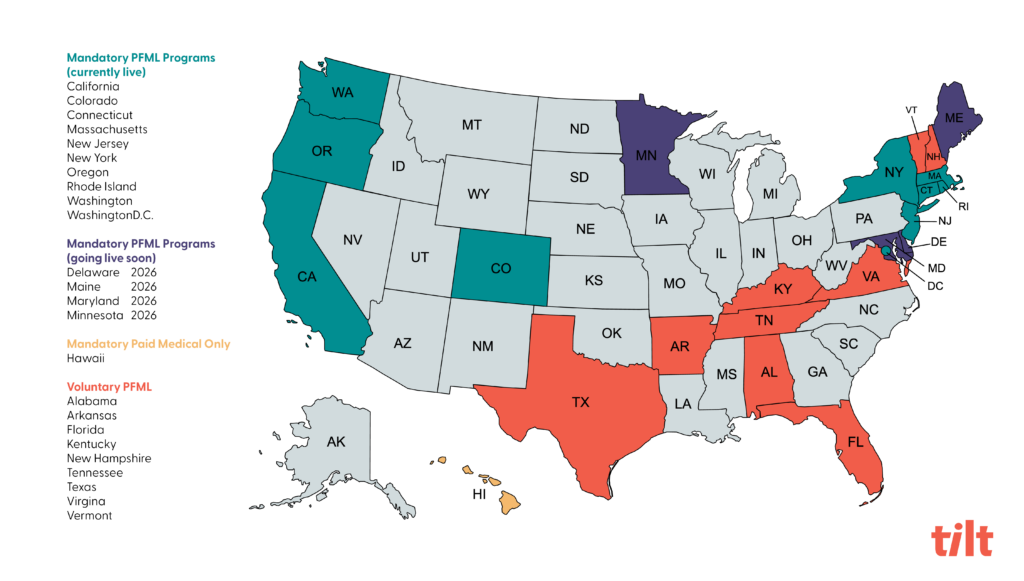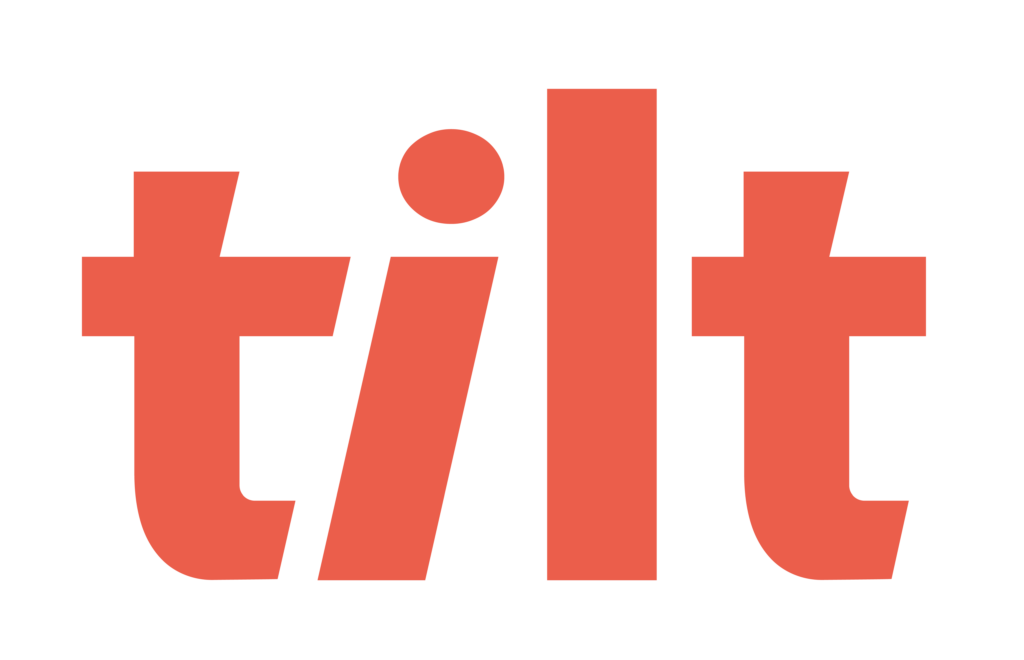The progress of paid leave support for employees in the United States has historically been a rather slow-moving one. Starting in 1942 with Rhode Island, which created a temporary disability insurance program to provide partial wage replacement to individuals who are injured and unable to work, it wasn’t until some 60 years later in 2002 that the first state (California) enacted a paid family leave program to provide support for employees taking parental leave.
While history tends to repeat itself, it doesn’t always do so at the same rate of change. In the case of leave trends, the momentum has rapidly picked up speed since California laid out the paid family leave blueprint.
HR Is Feeling The Pressure To Keep Up With Leave Laws
As of 2019 there were four (4) states with paid family leave programs (California, New Jersey, Rhode Island, and New York) with four (4) more (Washington, Massachusetts, Connecticut, and Oregon) and D.C. that had adopted programs yet to be implemented.
Today, only five years later, 13 states and D.C. have enacted mandatory paid family programs with eight (8) enacting voluntary programs which allow the provision of the benefit in the private insurance market.

Of course, paid family leave programs are only one aspect of leave policies that HR must be familiar with and adhere to, in fact today, there are over 400 state leave laws, and only about 10% of them cover family and medical leave reasons. On top of that, paid family leave programs on their own only represent a portion of family leave-related policies HR teams must be familiar with.
A “Care Matters” report card developed in 2021 by The Century Foundation that looks at five major policy areas to measure each state’s progress toward the goal of enacting the ideal care policies that support children, families, and communities. The policy areas are:
- child care and early learning;
- home and community-based services/long-term care;
- paid family and medical leave;
- paid sick and safe days; and
- fair working conditions for care workers.
The map’s 2024 version below scores every state based on the above criteria, and visualizes the true complex nature of policies across the country. This underscores just how chaotic, frustrating, and stressful it is for HR to try to effectively and compliantly support employees in a rapidly evolving leave law landscape.
If the map above shows anything it’s that:
a) no two states do things exactly the same
b) the country has a long way to go until all states are offering paid family
c) the impact of this complexity on business operations is painfully obvious and HR needs help
As new benefit programs continue their trend of popping up all over the country, and existing programs continue to evolve to meet the needs of employees everywhere, expect HR to be frantically searching for answers in their efforts to effectively and compliantly support employee leaves of absence.
Tilt Recap: Keeping up with leave trends means staying on top of leave laws as they evolve and adhering to them no matter where employees reside. As more and more states adopt their own unique version of paid family leave programs, leave of absence management is only becoming more complex for HR and People Ops teams to get right.
HR’s Role in the Rise of Organizational Leave-Related Policies
To paint a more complete picture of the pressures HR face when managing leaves of absence, it’s important to note that leave trends extend beyond the realm of public policy.
As organizations seek ways to improve benefit offerings for reasons ranging from, “it’s the decent thing to do,” to, “it’s better for business,” the arms race for talent acquisition and retention has led to an increase in organizational policies that HR now has to manage and administer.
This, of course, has only been compounded by the fact that employees requesting leaves are on the rise as views on mental health, among other external factors, take center stage in societal discourse.
“We’ve seen almost a doubling in mental wellness leaves of absence. I think the medical leave space will just continue to evolve as we wake up to the fact that there is more that happens in people’s lives that need protection and coverage.” – Jen Henderson, CEO of Tilt
Organizations offering more robust policies and the general reduction of stigmas around taking leave of absence have contributed to leave requests trending up and to the right with no signs of slowing down.
These leave requests are falling in the laps of overworked and ill-equipped HR and People Ops teams who are being asked to successfully absorb this uptick, a seemingly impossible task on it’s own, amplified by the unexpected nature of leaves.
A single leave request can derail even the most well-oiled team, a dozen can halt organizational productivity altogether.
To be clear, organizations offering more leave of absence policies is a good thing, a great thing even, but the burden of implementing these policies and supporting employees needing leave in life’s biggest moments are pushing HR teams over the limit, leading to some HR professionals seeking other lines of work altogether.
Tilt Recap: Organizations across the country are doing right by employees and expanding their leave benefits policies, but HR is still required to effectively manage complicated leaves with old solutions and processes. As leave requests rise, HR is feeling the squeeze.
HR Technology To Easily Keep Up With Leave Trends
Modern problems require modern solutions, and if HR has any hopes of keeping up with leave trends an honest examination of existing processes needs to take place.
Relying on manual spreadsheets and ineffective systems to manage leaves have always been an obstacle to effective and compliant employee support, but in the world of leave scale truly necessitates operationalizing systems and processes.
“When I went through my leave experiences in corporate America I thought there must be a better way, and I realized you needed to operationalize it. This way everyone has the same leave experience, everyone goes through the same process, and you reduce the probability of leave-related discrimination, bias, and sometimes even legal hot water.” Jen Henderson, Tilt CEO
Tilt’s approach to leave of absence management makes scaling your leave support as simple as humanly possible. While Tilt’s platform automates leave plans, calculates payroll, and tracks and guides employees through leave effortlessly, it does so while incorporating all of the latest leave laws along with every specific company policy you have today and may have tomorrow.
To put it simply, Tilt evolves as leave trends do.
That’s HR relief worthy of a pizza party.
With Tilt, HR compliance fears and process frustrations go the way of the dodo, keeping HR teams on track to successfully execute on key strategic initiatives that can drive business forward while delivering unrivaled support to employees.
Take a tour of Tilt’s HR dashboard below and see how easy it is to manage leaves at scale with Tilt.
Of course scaling leave support can’t all be technology-based. Leave, afterall, is perhaps one of the most human experiences your employees may go through.
In the age of AI, Tilt understands how important human connection is during a leave of absence.
“When you have the loss of a pregnancy or the loss of a newborn baby and those parental leaves turn into bereavement leaves, oftentimes employers have absolutely no idea what to do with that, how to support that, how to navigate it, or how to put it into their system.” – Jen Henderston, Tilt CEO
That’s why Tilt pairs every employee needing a leave with a human (one with a beating heart and everything) we call Empathy Warriors (LinkedIn translation: Leave Success Managers), and that human is their 1-1 go-to for guidance from the moment the employee’s leave journey begins until they’ve been successfully reintegrated into the workforce.
Acting as an extension of your team, Tilt is the one solution that not only provides comprehensive and empathetic support to employees, but adapts to the external trends that have been sinking HR and People Ops teams deeper into the depths of stress more and more every year.
Tilt Recap: The old way of managing leaves of absence was never ideal, but given the leave trends of the day, it’s become completely untenable. Trusting Tilt to manage leaves of absence provides tangible relief for HR and People Ops teams, who no longer have to worry about leave law evolution, rises in leave requests, or wondering if employees are getting consistent, superior support when they need it most.
About Tilt
Tilt is leading the charge in all things leave of absence management through easy-to-use tech and human touch. Since 2017, our proprietary platform and Empathy Warriors have been helping customers make leave not suck by eliminating administrative burdens, keeping companies compliant, and providing a truly positive and supportive leave of absence experience for their people.







